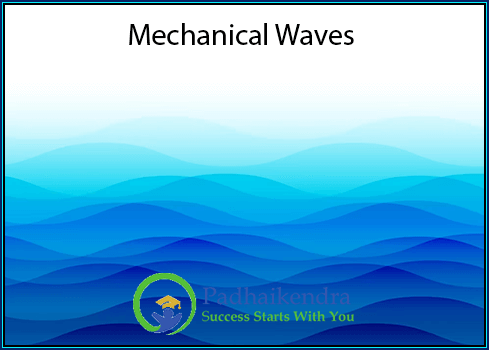Mechanical waves are waves that need a medium to travel through. This medium can be a solid, liquid, or gas. Mechanical waves happen when particles in this medium vibrate. These vibrations move from one particle to the next, and that’s how the wave moves through the medium.
Speed of a Mechanical Wave
By multiplying the wavelength and the frequency together, you can determine the speed of the mechanical wave in the medium. It’s important to note that the speed of a wave depends on the properties of the medium through which it is traveling. Different mediums can affect the speed of the wave, so the calculation may vary depending on the specific medium being considered.
The speed of a mechanical wave in a medium can be calculated using the equation:
Speed = Wavelength x Frequency
Here, the wavelength is the distance between two consecutive crests or troughs of the wave, and it is usually represented by the symbol λ (lambda). The frequency is the number of waves that pass a point in a given amount of time, and it is usually represented by the symbol f.
Types of Mechanical Waves
There are two main types of mechanical waves: transverse waves and longitudinal waves. Transverse waves happen when particles vibrate up and down, perpendicular to the wave’s direction. An example of a transverse wave is a wave on a string. Longitudinal waves happen when particles vibrate back and forth, parallel to the wave’s direction. An example of a longitudinal wave is a sound wave.
Properties of Mechanical waves
Mechanical waves have certain properties. The amplitude is the distance from the middle position to the highest or lowest point of the wave. It tells us how much energy the wave has. The frequency is how many waves pass a certain point in a specific amount of time. We measure frequency in hertz (Hz). The wavelength is the distance between two consecutive high or low points of the wave. It is inversely related to the frequency, meaning that longer wavelengths have lower frequencies. The speed is how far the wave travels in a given time. It depends on the properties of the something it’s traveling through and its frequency.
Uses of Mechanical waves
 Mechanical waves have many uses. They help us communicate by carrying sound and music. They power machines like engines and motors. They also play a role in medical imaging, creating images of the inside of our bodies, like ultrasound. In addition, they are important in the study of earthquakes, known as seismology.
Mechanical waves have many uses. They help us communicate by carrying sound and music. They power machines like engines and motors. They also play a role in medical imaging, creating images of the inside of our bodies, like ultrasound. In addition, they are important in the study of earthquakes, known as seismology.
Reflection and Refraction of Mechanical Waves
When mechanical waves encounter a boundary or a different medium, they can undergo reflection and refraction. Reflection occurs when a wave bounces back after hitting a surface, like an echo bouncing off a wall. Refraction happens when a wave changes direction as it passes from one medium to another, such as light bending when it enters the water. These phenomena play a significant role in how waves interact with their surroundings.
Interference of Mechanical Waves
Interference occurs when two or more waves meet and combine. There are two types of interference: constructive interference and destructive interference. Constructive interference happens when waves combine to produce a larger amplitude, resulting in a stronger wave. Destructive interference occurs when waves combine to cancel each other out, resulting in a weaker or no wave. Interference is observed in various natural phenomena and is also utilized in applications such as sound systems and radio technology.
Standing Waves
A standing wave is formed when two identical waves traveling in opposite directions meet and interfere with each other. This interaction creates stationary points called nodes and points of maximum displacement called antinodes. Standing waves have distinct patterns and frequencies determined by the size and shape of the medium. They can be observed in musical instruments, such as guitar strings or organ pipes, and have important implications in fields like acoustics and resonance.
To sum it up, Mechanical waves are an essential part of our world. They have various applications and help us understand how things work in the universe.





